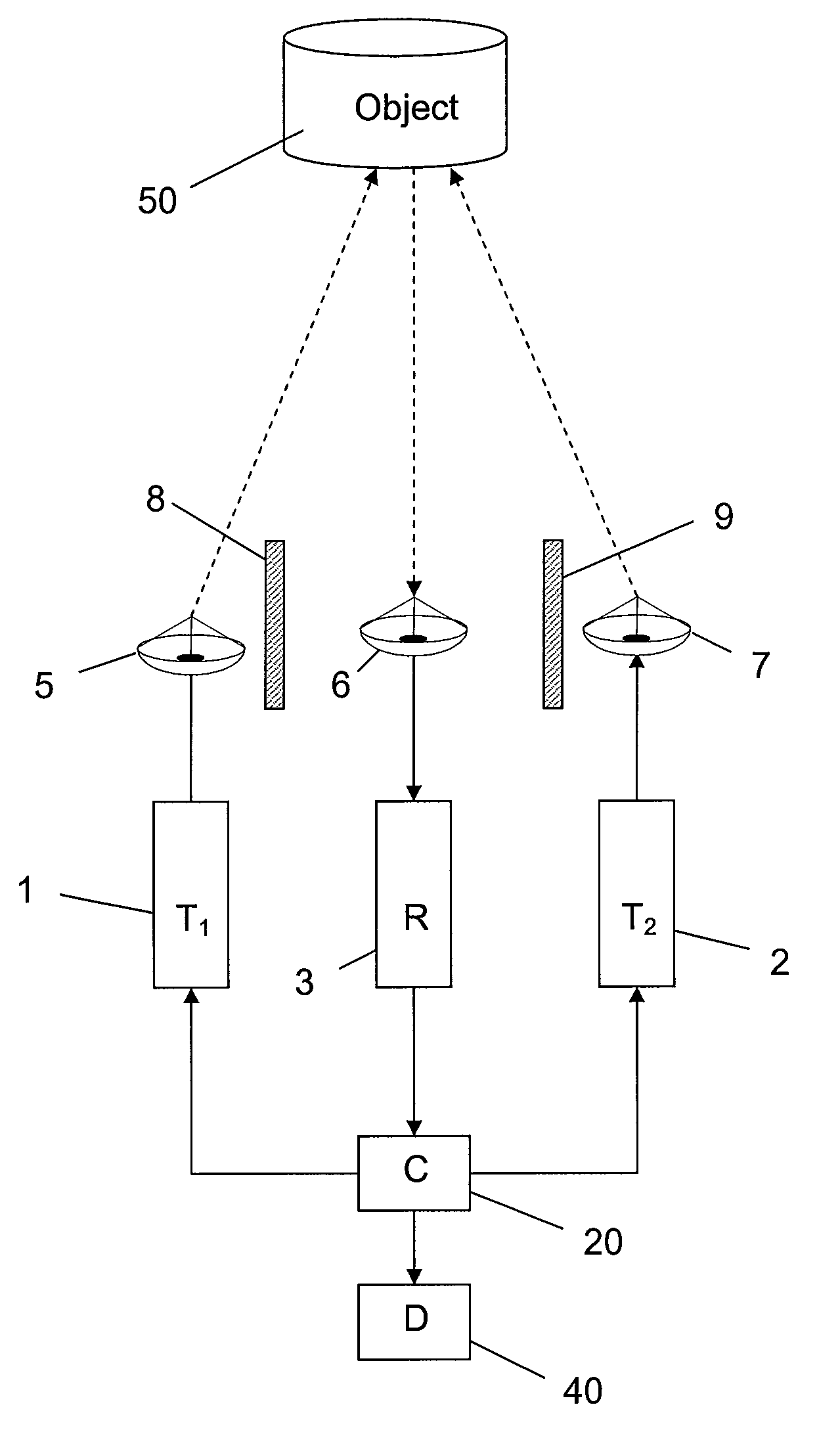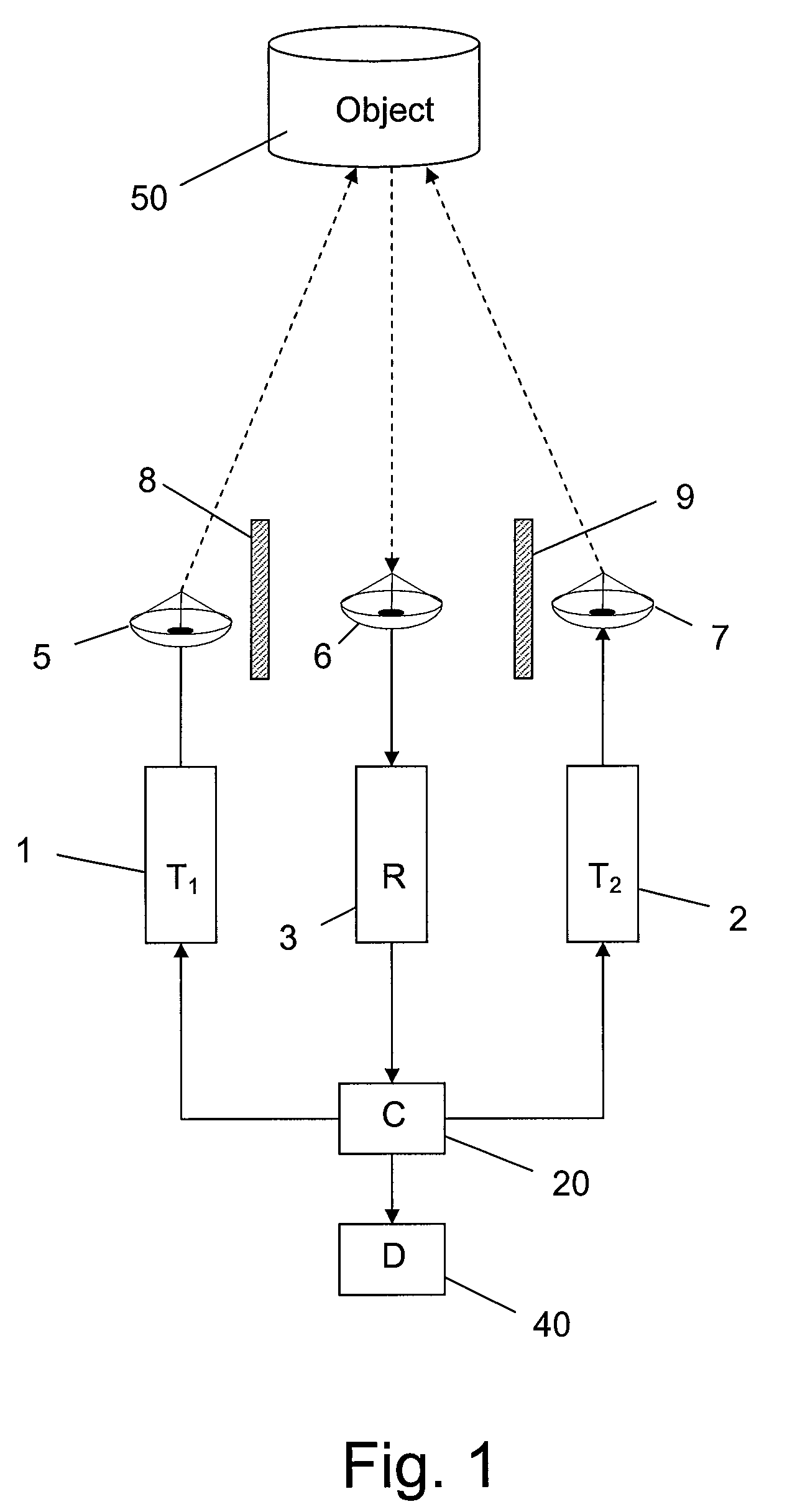Radar system and method
a radar and system technology, applied in the field of radar systems and methods, can solve the problems of short voltage, ineffective coupling, and difficulty in concentrating low frequency radiation on targets
- Summary
- Abstract
- Description
- Claims
- Application Information
AI Technical Summary
Benefits of technology
Problems solved by technology
Method used
Image
Examples
example 1
[0071]The following is an example for an efficient frequency selection that provides a system having high sensitivity to the detection of man-made objects. According to this example the transmitting frequencies are f1=2.74 GHz, f2=1.26 GHz, and the reception frequency is fr=4.0 GHz (being the sum f1+f2). Note that all frequencies in this example are rounded values to within 10 MHz. In that case the harmonics created at the transmitter 2 are in frequencies 5.48 GHz, 8.22 GHz, 10.96 GHz, . . . etc., and the harmonics created at the transmitter 4 are in the frequencies 2.52 GHz, 3.78 GHz, 5.04 GHz, . . . etc. It has been demonstrated that in this example the receiving frequency, when properly selected, is remote enough from each of the transmitting frequencies, and / or from any of their harmonics. Therefore, the sensitivity and the ability of the system to distinguish man-made target from their surroundings are improved.
[0072]In one preferred embodiment of the invention, the system of t...
example 2
[0082]The following example compares two radar systems radiating same pulse energy.
[0083]Radar system a, similar to the system of WO 02 / 39140 (Jablonsky et. al., also mentioned in the “Background of the Invention” section) emits typical pulse width τa=0.3 ms with typical pulse peak power Pa=0.3 W.
[0084]Radar system b, having transmitted pulse width as in the present application, typically τb=10 ns, and the same pulse energy as in Radar system a: pulse peak power Pb=9 kW.
[0085]Note that if both use same pulse repetition frequency (PRF), they also emit the same average power. For example a>=b>=0.1 W for PRF=1111 pps.
[0086]The re-radiated n-harmonic power from a non-linear object as discussed in the present application is proportional to the n-power of the flux (power density) impinging on the object. That straight forward rule applies, at a certain domain, to any non-linear phenomena of order n. In conventional (linear) radars, however, the re-radiated (or reflected) power is proporti...
example 3
[0094]Following the comparison between the two harmonic radars of EXAMPLE 2, we now analyze the implications of extending the range from 10 m to about 500 m. For the analysis to be meaningful, it is assumed that both systems use the same repetition rate, integration method, antennas, same receiver, and both look for the same object.
[0095]Radar system a, similar to WO 02 / 39140 (Jablonsky et. al. also mentioned above and in the “Background of the Invention” section) emits typical pulse width τa=0.3 ms with typical pulse peak power Pa=0.3 W.
[0096]Radar system b, having transmitted pulse width as in the present application, typically τb=10 ns, and the same pulse energy as in Radar system a: pulse peak power Pb=9 kW.
[0097]Radar system a, has a typical detection range of 10 m and we ask what is the required pulse energy or average power to extend the detection range to 500 m.
[0098]Re-writing the SNR relation of EXAMPLE 2:
SNR∝τ×(PG / 4πR2)n×Gr(λr / 4πR)2∝E×Pn−1R−(2n+2); E≡τ×P
where R is the ra...
PUM
 Login to View More
Login to View More Abstract
Description
Claims
Application Information
 Login to View More
Login to View More - R&D
- Intellectual Property
- Life Sciences
- Materials
- Tech Scout
- Unparalleled Data Quality
- Higher Quality Content
- 60% Fewer Hallucinations
Browse by: Latest US Patents, China's latest patents, Technical Efficacy Thesaurus, Application Domain, Technology Topic, Popular Technical Reports.
© 2025 PatSnap. All rights reserved.Legal|Privacy policy|Modern Slavery Act Transparency Statement|Sitemap|About US| Contact US: help@patsnap.com



